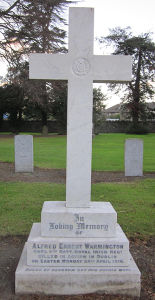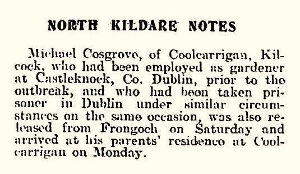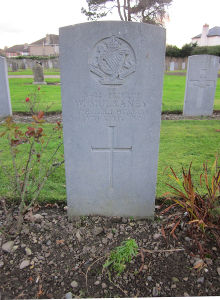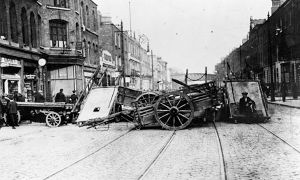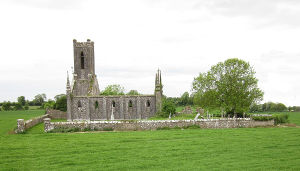Timahoe Connection to the Easter Rising 1916
Details the connections of a rural district in West Kildare to the Easter Rising 1916
Published in The Bridge by St Mochua Society, 2014
Introduction
The Easter Rising in 1916 was one of the most important events in Irish history and marked a turning point in the history of Ireland. It began the Irish revolution which led to Ireland obtaining self-determination. In the wider context it destabilized the British Empire and ultimately led to many countries following the example of Ireland and obtaining independence.
The rising was fought mainly in Dublin with minor outbreaks in a number of other counties. County Kildare also had an involvement which is well documented. The legendary story of 15 men marching from Maynooth to the GPO in Dublin to take part in the fighting is well known and well documented. But that wasn’t the only connection for the county. Individuals from a number of different areas in the county participated in the fighting on the rebel side and Irish Volunteers in the county itself mobilised and were available to assist the rebels.
There was also a substantial Kildare based British army connection to the rising with army units and reservists from the county been called up and participating in the fighting in Dublin.
Sadly as in every violent conflict non participants are affected with many either accidentally killed or injured. Some of the innocent civilian fatalities in Dublin were from county Kildare.
Many of the principal towns and districts in the county had an involvement. In the early days of the rising Irish Volunteer units in Athgarvan, Naas and Kill mobilised but were unable to act as they received no orders from volunteer headquarters. Individuals such as Jim O’Neill from Leixlip, Frank Bourke and his sister Eva from Carbury; Tom Harris from Prosperous, Mark Wilson from Athy and a character known as ‘Devil’ Daly from Sallins participated in Dublin on the rebel side and as such gave their respective districts a connection to the rising.1
Fatalities connected to Kildare
Fatalities in the rising connected with county Kildare include two members of the British Army, one rebel and a number of civilians. A Naas man Captain Alfred Ernest Warmington of the 6th Battalion, Royal Irish Regiment was killed during the rising on 24th of April 1916.2 He was the only son of Alfred Warmington senior, manager of the local Munster and Leinster bank in Naas. His military career commenced when he enlisted at the beginning of the Boer war, where he took part in the Battle of Spion Kop. He subsequently returned to civilian life and worked for the Great Southern and Western Railway. Following the outbreak of the First World War, he re-enlisted and served in France. Shortly before Easter 1916 he returned from active service in Flanders and was stationed in Richmond Barracks, Dublin. He was killed on Easter Monday while leading a charge on the Irish Volunteer position at the South Dublin Union.3
George Geoghegan was a member of the Citizen Army who was killed during heavy fighting on the morning of Wednesday 26 April in the area of Dublin Castle. He was of Dublin background and lived all his adult life in the capital but had a county Kildare connection as he was born in the Curragh Camp in 1880. At the time his father Peter Geoghegan was a drummer serving in the RDF, City of Dublin Militia, that was stationed for a short time in the Curragh Camp.4 George Geoghegan who was employed at the railway works at Inchicore, was married with three children and lived in Cork Street, Dublin.
Two of the civilians that died in the rising had north Kildare connections. Francie Salmon, was from Straffan and he was buried in Lyons Graveyard. Peter Connolly who was killed in North King St is interred in Donacumper Graveyard, Celbridge.5
Important West Kildare Connection
Carbury’s connection to the rising is a result of the involvement of two members of the Bourke family of Coonough. Frank Bourke was a student in St Enda's of Rathfarnham where the headmaster was Padraig Pearse. Together with other students from the school he mobilised on Easter Monday to assist in the rising and were assigned to the GPO garrison. After the surrender, Bourke was imprisoned in Frongoch and was one of the last seven county Kildare Easter Week prisoners that were released on 24th December 1916.6 His sister Eve a member of Cumann na mBan also had an involvement in the rising and attended the injured including James Connolly.7
The Prosperous connection with Easter Week centres mainly on the involvement of Tom Harris who was raised in the village by his aunt Elizabeth Tierney.8 During holy week in 1916, Harris was in close contact with Tom Byrne and Ted O’Kelly the two Irish Volunteer organisers for county Kildare and assisted in passing on details of the rising to other Volunteers in the county. On Easter Monday all three cycled to Maynooth and joined with Domhnall Buckley’s Maynooth contingent in marching to the GPO.9 Harris was wounded in the fighting and following hospitalisation was imprisoned until 3 August 1916. Bridget Cosgrave Burke a native of Landenstown also had an important connection to the rising. At the time she lived in James Street, Dublin and was the Mother of three sons that participated as Irish Volunteers in the fighting in the South Dublin Union. W.T.[Willie] Cosgrave, and his brother Philip Cosgrave were both initially sentenced to death for their involvement but the sentence was commuted to life imprisonment.10 However their step-brother Frank Burke, Bridget’s youngest son died in the fighting.
A Timahoe Involvement
Timahoe, is another area in west Kildare that had an important involvement in Easter Week with three individuals from the area connected to the rising. This locality is a small rural district and well-known as an area with an important local history connected to almost every period in Irish history.
Michael Cosgrove
The first individual from the Timahoe area with Easter Week connections is Michael Cosgrove who was the son of Peter Cosgrove of Coolcarrigan. In 1916 Michael was employed as a gardener in Castleknock and was an active member of the Irish Volunteers. During Easter Week he was one of the 304 men and women members of the Four Courts Volunteer garrison commanded by Commandant Ned Daly. Throughout the course of the week particularly on Wednesday and Thursday there was heavy fighting in the area of the Four Courts as the British military attempted to push forward towards O’Connell Street from Parkgate Street. Following the surrender Cosgrove was deported with the other prisoners and was detained in Frongoch Camp in Wales. However, on 22nd July 1916 many of the lesser known prisoners including Cosgrove were released.11 The Kildare Observer on 29th July 1916 published details of his release and return to his parents residence at Coolcarrigan.12
Michael’s brother Hugh Cosgrove also had an involvement in the Irish Revolution. He was arrested for involvement as an Irregular during the Civil War and in later life between the 1940s and the 1970s represented the Timahoe area as a county councillor.13
William (Bill) Mulreany
The second individual connected to Timahoe and the rising was William Mulreany who was originally from Carrick near Edenderry. He was from a family that had a tradition of service to the British Army. His brother Christy joined up at the age 18, but died of malaria in 1909 en route to India.14 William joined the army in his youth and served in Boer War. Retiring from the army he obtained employment in the Timahoe area and resided in Hodgestown. In 1914 when war broke out again, William was called up as a reservist and served in the 8th King’s Royal Irish Hussars. He saw action at the front but suffered injuries as a result of gas poisoning. He was sent home to the Curragh military hospital to recuperate. By April 1916 he had recovered sufficiently to be able to take up his army duties again. However, when the rising broke out on Easter Monday he was discharged from the military hospital and ordered into action in Dublin. He died in an encounter with the rebels on the 26th of April and was buried in the military cemetery in Grangegorman.15 He left a young wife and one child who resided in Hodgestown.
This was not the last Mulreany fatality, William’s brother Barney, who was also employed in Timahoe before the war joined the army and won the ‘military medal’. He was promoted to the rank of a sergeant in the 7th Bedford Division but was killed in action leading his men in a charge in France in April 1917.16
Michael Kavanagh
The third individual connected to the rising and Timahoe area is Michael Kavanagh. Very little is known of his connection to the locality other than he was a native of the Ballinafagh area where the family had a burial plot in the local graveyard. According to the 1911 census he lived in Queens Square now Pearse Square off Pearse Street in Dublin. At the time he was a widower with six children under the age of 7. His 19 year old sister Nannie Kavanagh lived with him and it is likely she was caring for the children.17
In 1916 Kavanagh worked as a carter for Messers Wallace and it appears he was working on the bank holiday, Easter Monday when the rising broke out. One of the first actions of the army was to erect barricades and cordon off areas of the city. Rebels were also reported to have erected barricades in some areas. Among the items used for the barricades were horse drawn carts and lorries. A newspaper report of the incident indicated that ‘(Michael Kavanagh) met his death through refusing to deliver up his lorry for barricading purposes’.18 His death certificate indicated that he died of gunshot wounds which were inflicted on Easter Monday the first day of the Rising. Having been wounded he was taken to St Vincents Hospital but his wounds turned septic. He lived for 24 days and died on the 17th of May.19 He was 34 years old and as a result a young family were orphaned. His remains were brought back to county Kildare and interred in Ballinafagh Graveyard.
No memorial exists to any individual named Kavanagh in Ballinafagh and no record of a family with that name in the locality has so far come to light. As he had a family at the time of his death it is likely that relatives possibly grand children may come forward with some further information.
As yet it is unknown whether it was the army or the rebels that commandeered Michael Kavanagh’s lorry for the barricades, however, it was most likely the military. For what reason Kavanagh objected to this is unknown. It may well be that he was protecting his employers property or he could have refused to give up the cart due to his sympathy to the cause of the rebels. This was in contrast to others who assisted the army including a man that was a native of Hodgestown and employed by the London North Western Steampacket Company. His name appears in the list published in the Press of the names of the carters commended by General Maxwell for their bravery in the conveying from the North Wall ammunition for the troops to another part of the city during the Dublin fighting.20
The initial reaction to the rising both nationally and locally was of condemnation and there was little or no support for the actions of the rebels. This was also the case in Timahoe which suffered the loss of two individuals from the locality. The rising was condemned by both politicians and the Catholic Church. One of the most vocal denunciations was given at a confirmation ceremony in Allen parish church on the 7th of May 1916 by Dr Foley, bishop of Kildare and Leighlin. He indicated that ‘none of the grievance which justify a rebellion are present in this country and that the English government was the best and most democratic government in the world’. He also threatened to excommunicate any person in the Catholic religion who takes up arms to resist the civil authority or who aids and abets those doing so.21 However, the political mood in nationalist Ireland changed throughout the summer and autumn of 1916 and as the Kildare prisoners were liberated either individually or in groups, their release was generally welcomed.
Conclusion
The centenary of the 1916 Rising will be commemorated in the near future. Individuals that participated on the rebel side include some who paid the ultimate sacrifice for their cause and others such as Michael Cosgrove who risked their lives. A special tribute will paid to them during the commemorations and they will be given credit for the contribution they made to Irish history.
It would also be a noble deed to remember in a special way and show respect to the fatalities from among the security forces, many of whom were Irish. They include officers of the Dublin Metropolitan Police and members of the British military such as William Mulreany.
Equally, civilians such as Michael Kavanagh who were killed or injured in the fighting should not be forgotten during the commemorations. Hopefully a way can be found of paying respects to those innocent individuals and indeed all who shed blood in a rebellion that commenced a process that led to the Irish Independence that we all enjoy today.
Footnotes
- Witness Statement 850 Patrick Colgan, p. 36; Devil Daly earned his nickname as a footballer playing for Sallins GFC.
- For a profile of Alfred Warmington see Kildare Observer; Con Costello, A Perfect English Station, p 294.
- Kildare Observer, 5 May 1916; Warmington was 41 years old when he died.
- General Record Office, Irish Life Centre, Dublin.
- For details of Francie Salmon see Ardclough Club and community 1936–2000 a celebration; Details of P. Connolly from his memorial in Donacumper graveyard also General Register Office.
- NAI, Csorp 18970/16 also 17714/16
- James Durney, On the One Road, p 29.
- Tierney’s house could be termed a revolutionary house as it was the residence of Thomas Wilde who was a leader of the 98 rebellion in Prosperous and later a leader of the Emmet conspiracy in 1803.
- Details of Harris’s involvement see Witness Statement 320 of Thomas Harris.
- W.T. Cosgrave later served as President of the Executive Council of the Irish Free State 1922–32.
- NAI, Csorp 15564/16
- Kildare Observer, 29 July 1916
- Brian Donnelly, ‘Local Government in Kildare, 1920–1970’, in William Nolan and Thomas McGrath (eds.), Kildare History and Society, pp 708–9.
- I am grateful to Declan O’Connor, Maynooth for details on the Mulreany brothers.
- Leinster Leader, May 1916.
- Kildare Observer, 14 April 1917.
- Census Dublin city 1911.
- Leinster Leader, June 1916.
- General Record Office, Irish Life Centre, Dublin.
- Leinster Leader, June 1916; Kildare Observer, June 1916.
- Kildare Observer, 13 May 1916.

